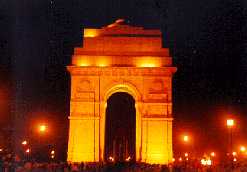 New Delhi is one of the major gateways of entry into India.
It is the third largest city in India with its twin city
Delhi.The new city became the Capital of India in 1911.New Delhi
is comparatively well planned with broad avenues and streets
as compared to Old Delhi- which is of great historical importance.
New Delhi is one of the major gateways of entry into India.
It is the third largest city in India with its twin city
Delhi.The new city became the Capital of India in 1911.New Delhi
is comparatively well planned with broad avenues and streets
as compared to Old Delhi- which is of great historical importance.Delhi has had a hoary past dating back to the epics of India. In the middle ages it was subjected to sucessive invasions from north (Afghanistan,Central Asia etc) and each invasion has left its mark in the form of various monuments, tombs, palaces and architectural relics. The temperature in Delhi ranges from 5*C to 20*C in winter months (Oct to Mar) and 35*C to 45*C in summer. The languages spoken are Hindi and Punjabi. English is also widely spoken and understood. For the discerning tourist Delhi is too sprawling a place with with ancient monuments and remnants of a bygone era to visit in one day. Atleast 2 to 3 days will be required to cover the more important places.
Places of tourist interest Iron pillar in the Qutb complex is a wonderful iron shaft dating back to 4th century ad.24ft tall this pillar stands there for 15 centuries in rain and sun but is absolutely rust free-a tribute to the metallurgical skill of the ancient Indians. The brahmi inscription on it tells us that it was erected by the Hindu king Chandragupta(375 to 413 ad) and was brought here by the Anang Pal the Tomar king. India GateThis great monument of the modern times is 42 meters high with a stone arch.It has the names of Indian soldiers who died in the first world war. Below in the center burns the Amar Jawan Jyothi in the memory of unknown Indian soldiers who died in various battles. This is a prominent land mark in New Delhi. Jantar Mantar This claborate observatory was built in 1725 by the Maharaja Sawai Jai Singh of Jaipur, a noted scholar in mathematics and astronomy himself.The huge structures and various yantras of the observatory are a sure sign of its builder's great astronomical prowess. Laxmi Narayan Temple is another place of worship to devout Hindus. It was built in the year 1938 by Raja Baldev Birla, a prominent Indian industrialist of the Birla family. Built in Orissan style with marble the presiding deities there are Narayana(The Preserver,) and Lakshmi(the goddess of Wealth).Gita Bhavan and a buddhist temple are situated on either side of the main temple. Baha'i House of Worship(The lotus Temple) Near Nehru Place is situated this architectural building with a distinctive disign amidst sprawling lawns and large placid pools. This temple, shaped likle a huge lotus flower has 27 petals made of white concrete and clad in white Greek marble panels. Here people of all faith are welcome to visit the temple and to pray and meditate there in total silence. The temple is closed on Mondays for visitors.Its construction began in 1980 and was completed in 1986. This magnificent structure is ninesided. Nine is the highest digit and symbolises comprehensiveness, oneness and unity. Accordingly there are 9 pools and 27 petals(2+7=9, by numerological consideration).
Teen Murti Bhavan which was built earlier by the Britishers as the
official residence of the British commander-in-chief, became the official
residence of the first prime Minister of India, Pandit Jawaharlal Nehru.
Chandni Chowk:Meaning"silver Street" was once supposed to have
been the richest street in the world. Now, this is the most fashionable
business and shopping centre in Delhi, thronging with people and traffic
It was made wide enough to accommodate Shah Jahan's great processions.
It is also the most historically important thoroughfare in the world.
Spciality
Conducted tours:
Tourist Information:
Delhi Tourism Development Corporation Ltd |
 Qutb Minar is the epitome of the entry of the Islamic culture
into India.The tallest free standing stone tower in the world it is
234ft tall and is made of red stone and marble. Its five
stories have projected balconies. It was originally attached to a
mosque for the muezzin to call the faithful for prayers. The Qutb minar
represents the rich heritage of the bygone era.
Qutb Minar is the epitome of the entry of the Islamic culture
into India.The tallest free standing stone tower in the world it is
234ft tall and is made of red stone and marble. Its five
stories have projected balconies. It was originally attached to a
mosque for the muezzin to call the faithful for prayers. The Qutb minar
represents the rich heritage of the bygone era.